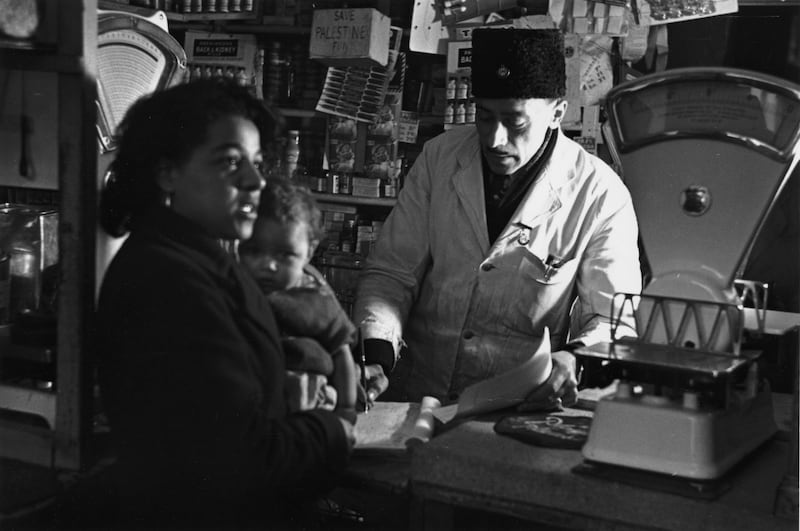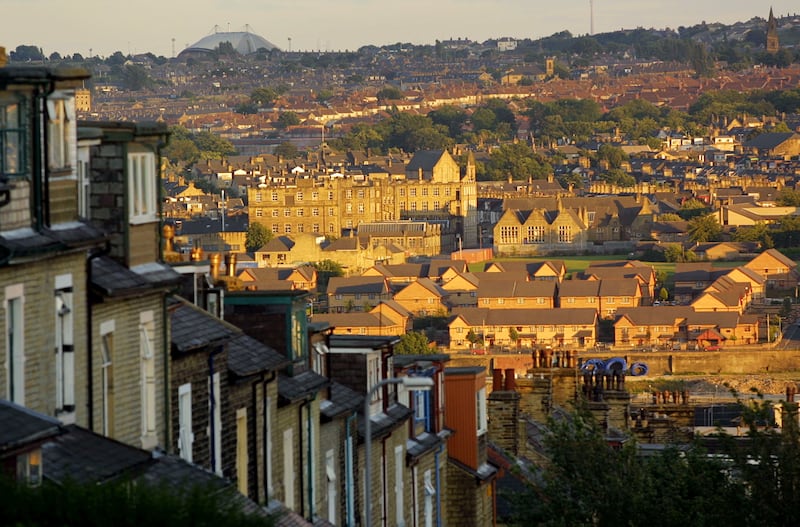A US anthropologist arrives in a British city to study its multiculturalism. On a street in a diverse enclave he counts two dozen cafes, many with African, Arab or Asian names. A local street performer entertains a crowd that is a kaleidoscope of different ethnicities including white people.
Further along he enters a public park and is met with more diversity. He sees a blonde toddler playing with a black girl of the same age. There is a couple, a white woman with an Arab man, while other children of different hues play together close by. Several are of mixed race.
Men walk by wearing fezzes, traditional Islamic headdresses closely associated with north African countries such as Morocco. Some of the women wear coloured turbans. At the end of the street lies a new mosque. A sign pointing to a local maternity hospital is written in English and Arabic.
This cosmopolitan summer’s-day scene of different races mixing freely and innocuously sounds utopian, the banality of the interactions a triumph of racial integration. It could be in London’s Kensington or Brixton. It could also be in Manchester or Leeds, ethnic melting pots of England’s north.
World Cup Fever: A Footballing Journey in Nine Tournaments by Simon Kuper - A life structured in four-year intervals
Political Girl: Life and Fate in Russia by Maria Alyokhina - A page-turning memoir
On My Watch by Jens Stoltenberg: a behind-the-scenes account of his Nato stewardship
Writer Eithne Shortall: ‘We put Irish at the heart of family life, one bedtime story at a time’
It is, in fact, Cardiff. But the year, somewhat surprisingly, is 1947, a full 12 months before the docking of the migrant ship HMT Empire Windrush that many people wrongly believe heralded the official starting point of multicultural Britain.
The scene above, which described the Welsh city’s portside enclave of Tiger Bay, is sketched from the contemporaneous notes of US anthropologist St Clair Drake, a black academic who went to Britain soon after the second World War.
It is laid out in academic Kieran Connell’s new book, Multicultural Britain: A People’s History, which takes readers on a chronological journey through the making of Britain’s modern multiracial society. Don’t ask “where are they from?”, Connell tells his fellow Britons. Instead, he urges his compatriots to ask themselves a deeper question: where are we from?
In a nation roiled with angst and uncertainty over the impact of immigration, the answer isn’t always clear. The recent emergence of Nigel Farage’s right-wing, anti-immigrant Reform UK party as a force in British politics shows that the framing of the question is also in flux for many people.

The widespread mixing of different races didn’t become common until decades after the arrival of Windrush. But Tiger Bay had been an isolated outpost of ethnic plurality since the middle of the 19th century. Men from the exotic outer reaches of Britain’s empire had flocked to the city to work in its sprawling port, a significant maritime trading hub.
In Tiger Bay, they “erected a community in their own image”, according to the book’s account of Drake’s academic notes. Their self-contained bailiwick was a sanctuary from the relentless racism they experienced everywhere else in Cardiff.
Quoting snippets of Drake, Connell describes the Tiger Bay mini “metropolis” the immigrants built in this little corner of southern Wales that became a microcosm of other ethnically diverse societies, such as the south side of Chicago, which the US anthropologist had studied previously.
“Places of worship, dive bars, dice rooms, political associations, chittering diners and cabaret joints; hustling, thinking, political organising and just ‘having a good time’. The metropolis was both a ‘struggle for liberty’ and a ‘tenacious clinging to life’,” he writes.
Some of the dark-skinned newcomers had sexual relationships with local white women, which sparked resentment among local men. Among the native white population, anxiety over interracial sex would become a recurring theme in the decades ahead, Connell’s book proves.
For the historian Connell, Drake’s notes are a gold mine of vivid colour and first-hand insight into the daily life of the denizens of Tiger Bay, which had a seedy side. He exploits it expertly. The notes describe in startling detail the goings-on in bookies and sex parlours, cafes and private homes.
During the second World War, up to 240,000 black US troops were stationed in the UK. A large number were in barracks in or around Cardiff. For some local women, these dark-skinned newcomers were seen as representing “a sense of exotic, modish urbanity”.
Up to 500 so-called “brown babies” were born to local white women from their encounters with US troops, the book suggests. These mixed-race children faced dreadful discrimination in Britain, where they were viewed as “symbols of immorality”, according to Drake.
Connell, a descendant of immigrants from Cork, draws on other sources such as contemporaneous newspaper reports to paint a compelling picture of the perception of scandal around these interracial encounters. In the US, where racial segregation was the norm, Tiger Bay became notorious and when it was reported there people were horrified.
There was also a tragic tenderness in some of the newspaper stories of the time. One tells how when the war ended and it became apparent that the troops would be returning home, scores of their distraught local lovers besieged a barracks singing the song the wartime anthem, Don’t Fence Me In. The black soldiers broke down the barbed wire fences separating them from the women and soon, Connell writes, there were hundreds of couples kissing and embracing in the field outside.
The stunningly detailed section examining Tiger Bay in the 1940s is by far the most compelling part of Connell’s social history of British multiculturalism. Unfortunately, the author’s rather dry and academic introduction to the book must first be scaled before readers get to the good stuff.
Other sections follow, focusing on multiculturalism in Nottingham in the 1950s and then the Balsall Heath area of Birmingham, where the author grew up, in the 1960s. The book moves on to Bradford in the 1980s, before he returns to Balsall Heath in the 1990s, when he reconciles his study of multiculturism with life experiences as a child during that period.

The Nottingham section delves into issues of racial politics and also deals with the emergence of so-called “race riots”, as tensions rose through the 1950s as mass immigration cranked up. In many cases, however, the riots were started by crowds of angry whites. Rather than race riots, they would be more accurately described as “racist riots”, Connell argues.
The Nottingham section includes glorious excerpts from the unfinished memoir of a Jamaican immigrant, Eric Irons, who married a white woman. Similar to Drake’s notes on Tiger Bay, it gives Connell’s book amazing insight into the daily lives of immigrants at the time.
One memorable passage describes how the bracing cold of a British winter felt to the recently-arrived man from the temperate Caribbean: “You had to crouch further into your clothes and rub your hands together to keep warm.”
In the Nottingham section, the book makes a salient point about immigration to the once-imperial Britain. Many arrivals such as Irons who came from former colonies were brought up to see Britain as some sort of noble ideal purveyed by their imperial masters. Before arrival, the colonised felt they belonged to that ideal; they felt part of the empire. Yet when they arrived in the motherland, they were met with racism and often shunned. How bewildering that must have felt.
As the 1950s turned into the 1960s, tensions rose in Britain over immigration as the locals realised that their “coloured guests” were not a temporary addition to the country, as they had once been led to believe. Britain was changing forever.
The first Balsall Heath section goes into detail on the experiences of Irish immigrants, as the author sets out to prove that multiculturalism need not always be multiracial. Irish people in Birmingham had a difficult time there after the IRA pub bombing of 1974. But without the benefit of gripping first-hand accounts such as Drake’s or Irons’s, the later sections of the book fail to crackle in the way the Cardiff and Nottingham passages did. Connell lapses back into frequent bouts of earnest academic droning.
He reaches the conclusion that modern Britain is “overdue a reckoning with the legacies of Britain’s colonial past”, which chimes with the findings of other writers such as Sathnam Sanghera.
It is disappointing that Connell does not put greater effort into engaging with the arguments of white British people who have anxieties about the impact on their society of multiculturalism and mass immigration, despite a promise by him to do so at the start of the book.
No matter how misguided or unjustified some of those arguments may be, the fears and worries of the native population are as much a part of Britain’s multicultural history as the stories of immigrants and their descendants. White racism explains a lot about the tensions surrounding multiculturalism, but it cannot explain everything.
Another flaw in Connell’s book lies in his decision to completely ignore the story of London, Britain’s most culturally diverse city. Any history of Britain’s multiculturalism that does not include the story of its capital city must be viewed as incomplete. Connell never properly justifies his decision, which he tries to explain away by claiming that London is just too “different”. So why not chart that difference instead of skipping over it altogether?
Connell’s book is imperfect and its pace is inconsistent. But its bursts of colour and insights into daily lives of early multicultural societies mean it is still a worthwhile read on a topic that will remain at the heart of public debate in Britain for many years to come.
****
Recommendations
This is Not America by British-Nigerian writer Tomiwa Owolade provides a fresh perspective on issues of race and immigration in Britain. He makes a compelling case for why discussions of race in Britain should not be conflated with the culture war-driven debate in the US. Britain has its own story, he argues, and from his perspective it is sometimes a surprisingly positive one.
Ben Judah’s This is London is a stunning piece of reportage on the underbelly of the city where, often, immigrants are to the fore. It is billed as the “stories you never hear; the people you never see”. Judah tells the story of modern London through the eyes of its “beggars, bankers, coppers, gangsters, carers, sex workers and witch doctors” and the voices of its “Arabs, Afghans, Nigerians, Poles, Romanians and Russians”. Strap yourself in.
In her book Another England, former UK Green Party leader Caroline Lucas argues that the right wing of British politics has “hijacked Englishness” for its own ends. It must be reclaimed, she says.













